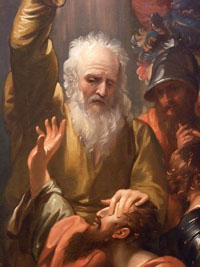| Notes: | Now there was a disciple in Damascus named Ananias. The Lord said to him in a vision, "Ananias." He answered, "Here I am, Lord." The Lord said to him, "Get up and go to the street called Straight, and at the house of Judas look for a man of Tarsus named Saul. At this moment he is praying, and he has seen in a vision a man named Ananias come in and lay his hands on him so that he might regain his sight." But Ananias answered, "Lord, I have heard from many about this man, how much evil he has done to your saints in Jerusalem; and here he has authority from the chief priests to bind all who invoke your name." But the Lord said to him, "Go, for he is an instrument whom I have chosen to bring my name before Gentiles and kings and before the people of Israel; I myself will show him how much he must suffer for the sake of my name." So Ananias went and entered the house. He laid his hands on Saul and said, "Brother Saul, the Lord Jesus, who appeared to you on your way here, has sent me so that you may regain your sight and be filled with the Holy Spirit." And immediately something like scales fell from his eyes, and his sight was restored. -- Acts 9:10-18 "This altarpiece depicts the conversion of St. Paul, one of the fathers of the Christian church. Previously an avid persecutor of Christians, Saul, —as he was originally known —was struck by temporary blindness while en route to the city of Damascus. Upon regaining his sight, he changed his name to Paul and became a Christian, going on to become one of the major authors of the New Testament. This painting served as a model for a painted glass window in St. Paul's Cathedral in Birmingham, England. It is the earliest and smallest of two versions of the subject by Benjamin West. He painted a later, sketchier treatment in response to the acclaim with which this altarpiece was greeted when it was exhibited in London at the Royal Academy." (Dallas Museum website) |
|---|

